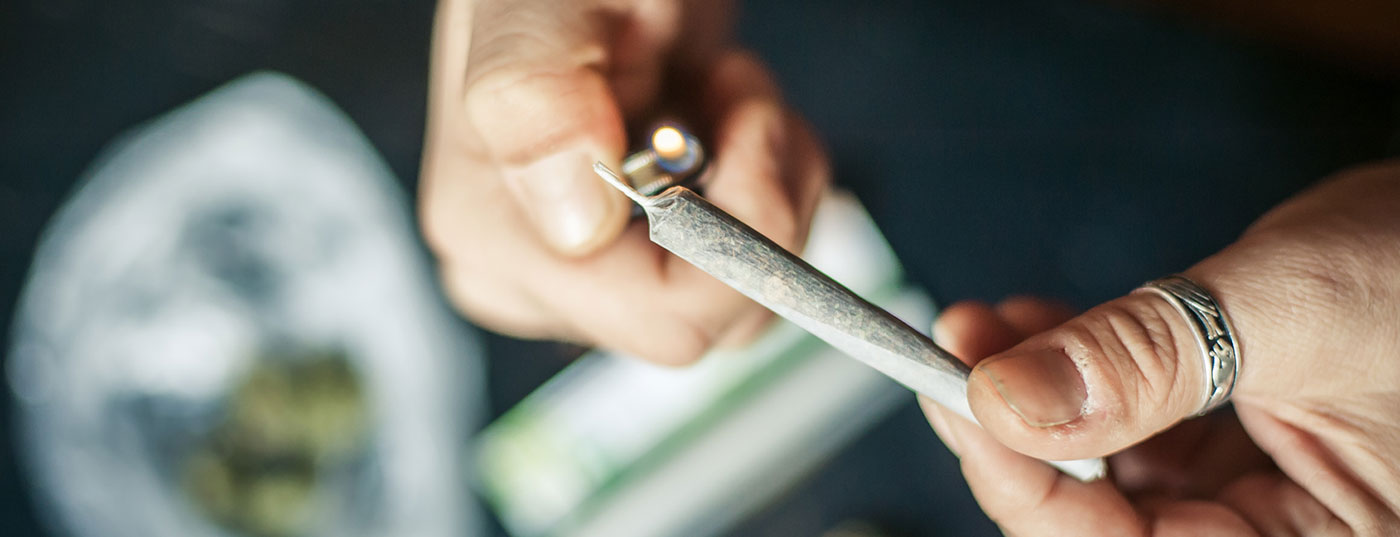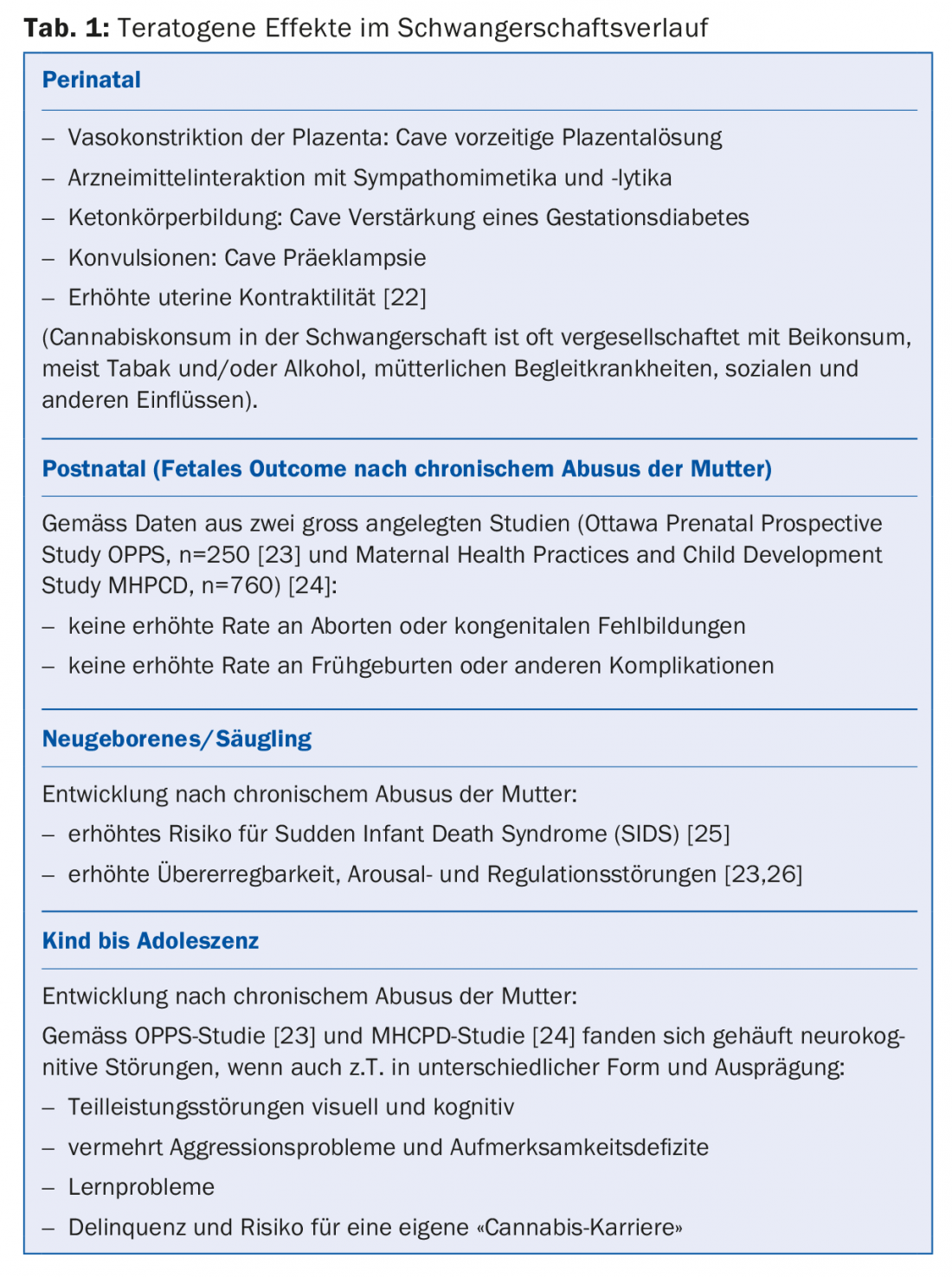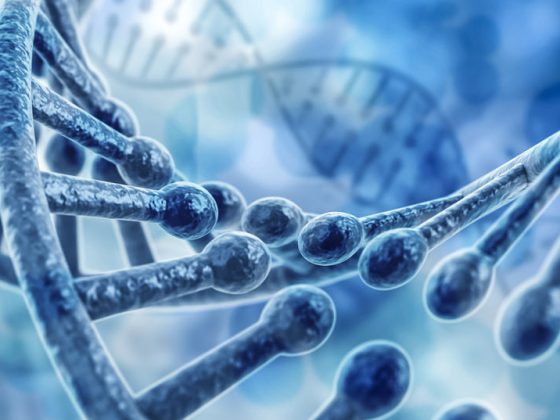Cannabis use has potentially harmful effects perinatally. However, the rate of abortions, congenital malformations, preterm births, or other complications is not increased. Chronic maternal cannabis abuse is associated with a higher risk of Sudden Infant Death Syndrome in infants and can lead to arousal and regulatory disorders in children.
Cannabis is an annual useful and ornamental plant and belongs to the hemp genus. Botanists distinguish between common hemp (C. sativa) and Indian hemp (C. sativa var. indica). Products include hemp fiber, oils and seeds. The following hemp extracts are considered intoxicants or psychoactive drugs (by binding to the cannabinoid receptors CB1 and CB2):
- Marijuana: dried petals and bracts; the resin secreted from the glandular scales is responsible for the effects. Marijuana is primarily smoked. Per “joint” about 0.2 g flower is mixed with tobacco.
- Hashish: the dried resin is smoked, chewed or eaten. 200 mg of hashish is equivalent to the effect of 1 g of marijuana. The resin represents a mixture of at least 40 so-called cannabinoids.
Among the active ingredients of importance are cannabidiolic acid (0.3-0.7%) or its degradation product, the psychotropically active delta-9-tetraydrocannabinol (Δ9THC or THC; 0.1-0.5%) [1]. Overall, THC content is reported to be increasing in the more modern plant varieties [2]. Synthetic cannabinoids “Spice” are about 500 times more potent [3]. In the U.S., marijuana was considered the most common painkiller until 1898. Since 1928 (Opium Conference) cannabis belongs to the opiates and is illegal, from 2004 an increasing legalization took place again, for example in many US states and Canada to use cannabis for medical purposes [2,5]. The heyday of hemp in Europe was around 1700 (nautical products, textiles, paper), the first traces of hemp use (in Asia) existed as early as 10,000 B.C. Between 1850 and 1930, over 100 different cannabis medicines were created in Switzerland [4]. Today there are great efforts to legalize, especially for medical purposes.
Epidemiological data
Cannabis use has been on the rise in recent decades in both the United States and Europe, affecting men in three-quarters of cases. Depending on the statistics, the prevalence is almost twice as high in the United States (about 8%) than in Europe (about 4%) [15,18,19].
Data on the prevalence of cannabis use (nicotine use) in pregnancy:
- USA: Total pregnancy: 5.2% (16%), first trimester: 10.7% (23.2%), second trimester: 2.8% (13.6%), third trimester: 2.3% (11.1%) [20].
- Switzerland: 2008 data show that the prevalence of cannabis use before the onset of pregnancy decreases from 5.4% to 2.1% (when pregnancy is known) and decreases to 1.5% after delivery [21].
Pharmacokinetics of THC
When tetrahydrocannabinol (THC) is ingested via inhalation or orally, an effect is achieved after 30-90 minutes, which lasts four to eight hours. Δ9-THC is predominantly oxidized in humans to 11-hydroxy-Δ9-THC (11-OH-Δ9 THC) (psychoactive) and further metabolized to 11-nor-9-carboxy-Δ9-THC (11-COOH-THC, THC-COOH, THC carboxylic acid, non-psychoactive). Over 100 different Δ9-THC metabolites have been identified in humans and animals, nearly all of which are non-psychoactive. Metabolization occurs mainly in the liver and by cytochrome P450 enzymes 2C9, 2C19, and 3A4 [6].
Psychological effects occur at 30 μg/kg to 50 μg/kg intravenously, 50 μg/kg by smoke inhalation, and 120 μg/kg orally. With smoke inhalation of 5 to 7 mg, the sedative component predominates, and with ≥15 mg, vigilance predominates [7]. THC is predominantly bound to proteins in blood plasma. Elimination from plasma develops in several phases: two to three shorter ones (several minutes to hours) and a terminal long one. The terminal half-life is reported to be 21 hours on average. After five days, about 80% to 90% of THC is excreted in the form of metabolites, about two-thirds in the stool and one-fifth in the urine [8].
Specific kinetics data for pregnancy do not exist. Placental clearance is rapid, and fetal serum concentrations exceed maternal concentrations [9]. The amount absorbed by the child through breast milk per breastfeeding meal is about 0.8% of the amount absorbed by the mother [10]. Detection in the mother is in urine, serum (several days to one month), and hair (several months to years); detection in the newborn is in meconium (second and third trimesters) or hair (third trimester).
Effects of THC in chronic use
- Chronic respiratory and circulatory disease due to elevated carbon monoxide levels (about five times higher than after smoking tobacco-only cigarettes) [11]
- Psychological changes: Sedation, euphoria, loss of reality, anxiety; personality changes [12]; long term: paranoia, hallucinations, psychosis.
- Impaired cognitive performance [13,14]
- Loss of impulse control [15]
- Loss of motor coordination
- Sympathetic activation: vasoconstriction, bronchodilation, increase in heart rate and lipolysis.
- Low addiction potential due to tolerance development, gateway drug to heroin!
- Social components: Higher unemployment [13,14,16], worse contraception [17]
Findings regarding breastfeeding
About 40-80% of mothers continue to use postnatally. A breastfed infant absorbs about 0.8% of the maternal dose [10], and in chronic users this dose is increased up to eightfold [27]. Cannabis inhibits milk production (prolactin decreases) [28].
Recommendations for breastfeeding vary. In the U.S., for example, recommendations vary widely. The AAP (American Academy of Pediatrics) discourages breastfeeding, the Academy of Breastfeeding allows breastfeeding [31], the Baltimore Addiction Center strongly warns [32]. In Switzerland, there is a lack of recommendations at the national level. Education of women in childbirth is an important measure. In the case of mild consumption without co-use, breastfeeding is permitted in Switzerland. In cases of heavy cannabis use due to reduced attention of the mother towards the child and sedation of the child (SIDS), breastfeeding is contraindicated (recommendations from the University Children’s Hospital of Basel UKBB).
With regard to consequences for the breastfed infant, the empirical data situation is rather limited. There is evidence of delayed motor development in infants one year of age [29], weakness in drinking, sedation with regular and heavy consumption by the mother [30], and Sudden Infant Death Syndrome (SIDS).
Take-Home Messages
- Cannabis use during pregnancy is associated with significant problems for both mother and child. Confirmed data on the harmful effect on the mother or the course of pregnancy and the fetus serve as a guide for the extensive malformation diagnostics that are indicated in every case.
- A complicating factor is the fact that cannabis is rarely consumed alone, but is usually mixed. In addition to all the potential effects, when caring for a drug-using pregnant woman, it should not go unnoticed that the general condition of the pregnant woman is often reduced.
- Drug-using pregnant women thus require intensive care and counseling by obstetricians, usually in collaboration with other medical disciplines including social psychiatry.
Literature:
- Garcia GL, et al: Cannabinoid receptor binding and mRNA levels in several brain regions of adult male and female rats perinatally exposed to delta9-tetrahydrocannabinol. Drug Alcohol Depend 1999; 55: 127-136.
- Warner TD, Roussos-Ross D, Behnke M: It’s not your mother’s marijuana: effects on maternal-fetal health and the developing child. Clin Perinatol 2014; 41: 877-894.
- Psychoyos D, Vinod KY: Marijuana, Spice “herbal high,” and early neural development: implications for rescheduling and legalization. Drug Test Anal 2013; 5: 27-45.
- Fankhauser M: Hashish as a drug. On the importance of Cannabis sativa in Western medicine. Swiss Society for the History of Pharmacy (SGGP/SSHP), Langnau: 2002, ISBN 3-9520758-9-2.
- Metz TD, Stickrath EH: Marijuana use in pregnancy and lactation: a review of the evidence. Am J Obstet Gynecol 2015; 213: 761-778.
- Gustafson RA, et al: Urinary pharmacokinetics of 11-nor-9-carboxy-delta9-tetrahydrocannabinol after controlled oral delta9-tetrahydrocannabinol administration. J Anal Toxicol 2004; 28: 160-167.
- Chiang CN, Rapaka RS: Pharmacokinetics and disposition of cannabinoids. NIDA Res Monogr 1987; 79: 173-188.
- Heuberger JA, et al: Population pharmacokinetic model of THC integrates oral, intravenous, and pulmonary dosing and characterizes short- and long-term pharmacokinetics. Clin Pharmacokinet 2015; 54: 209-219.
- Bailey JR, et al: JrFetal disposition of delta 9-tetrahydrocannabinol (THC) during late pregnancy in the rhesus monkey. Toxicol Appl Pharmacol 1987; 90 (2): 315-321.
- Djulus J, Moretti M, Koren G: Marijuana use and breastfeeding. Can Fam Physician 2005; 51 (3): 349-350.
- Macleod J, et al: Cannabis, tobacco smoking, and lung function: a cross-sectional observational study in a general practice population. Br J Gen Pract 2015; 65: e89-95.
- Gilman JM, et al: Cannabis use is quantitatively associated with nucleus accumbens and amygdala abnormalities in young adult recreational users. J Neurosci 2014; 34 (16): 5529-5538.
- Auer R, et al: Association between lifetime marijuana use and cognitive function in middle age: The coronary artery risk development in young adults (CARDIA) Study. JAMA Intern Med 2016; 176 (3): 352-361.
- Pedersen W, Skardhamar T: Cannabis and crime: findings from a longitudinal study. Addiction 2010; 105 (1): 109-118.
- Ansell EB, et al: Effects of marijuana use on impulsivity and hostility in daily life. Drug Alcohol Depend 2015; 148: 136-142.
- Meier MH, et al: Persistent cannabis users show neuropsychological decline from childhood to midlife. Proc Natl Acad Sci U S A 2012; 109(40): E2657-64.
- Morrison LF, et al: Protective factors, risk indicators, and contraceptive consistency among college women. J Obstet Gynecol Neonatal Nurs 2016; 45 (2): 155-165.
- National Institute on Drug Abuse (NIH). Marjuana. www.drugabuse.gov/drugs-abuse/marijuana, last accessed 18.10.2018
- European Monitoring Centre for Drugs and Drug Addiction. European Drug Report 2017: Trends and Developments. www.emcdda.europa.eu/publications/edr/trends-developments/2017_en, last accessed 18.10.2018
- Substance Abuse and Mental Health Services Administration. Results from the 2013 National Survey on Drug Use and Health: Summary of National Findings. www.samhsa.gov/data/sites/default/files/NSDUHresultsPDFWHTML2013/Web/NSDUHresults2013.pdf, last accessed 18.10.2018
- Grob A, Lemola S: Substance use screening in prenatal care. Study commissioned by the Federal Office of Public Health (FOPH) 2008.
- Murthy NVA, Melville GN, Wynter HH: Contractile responses of uterine smooth muscle to acetylcholine and marijuana extract. Int J Gynaecol Obstet 1983; 21 (3): 223-226.
- Fried PA: The Ottawa Prenatal Prospective Study (OPPS): methodological issues and findings – it’s easy to throw the baby out with the bath water. Life Sci 1995; 56 (23-24): 2159-2168.
- Goldschmidt L, et al: Early marijuana initiation: the link between prenatal marijuana exposure, early childhood behavior, and negative adult roles. Neurotoxicol Teratol 2016; 58: 40-45.
- Klonoff-Cohen H, Lam-Kruglick P: Maternal and paternal recreational drug use and sudden infant death syndrome. Arch Pediatr Adolesc Med 2001; 155 (7): 765-770.
- de Moraes Barros MC, et al: Exposure to marijuana during pregnancy alters neurobehavior in the early neonatal period. J Pediatr 2006; 149 (6): 781-787.
- Perez-Reyes M, Wall ME: Presence of delta9-tetrahydrocannabinol in human milk. N Engl J Med 1982; 307 (13): 819-820.
- Murphy LL, et al: Function of cannabinoid receptors in the neuroendocrine regulation of hormone secretion. Neurobiol Dis 1998; 5: 432-446.
- Astley SJ, Little RE: Maternal marijuana use during lactation and infant development at one year. Neurotoxicol Teratol 1990; 12 (2): 161-168.
- Liston J: Breastfeeding and the use of recreational drugs–alcohol, caffeine, nicotine and marijuana. Breastfeed Rev 1998; 6 (2): 27-30.
- Reece-Stremtan S, Marinelli KA: ABM clinical protocol #21: guidelines for breastfeeding and substance use or substance use disorder, revised 2015. Breastfeed Med 2015; 10(3): 135-141.
- Jansson LM, Bunik M, Bogen DL: Lactation and the marijuana-using mother. Breastfeed Med 2015; 10 (6): 342-343.
HAUSARZT PRAXIS 2018; 13(11): 23-25













